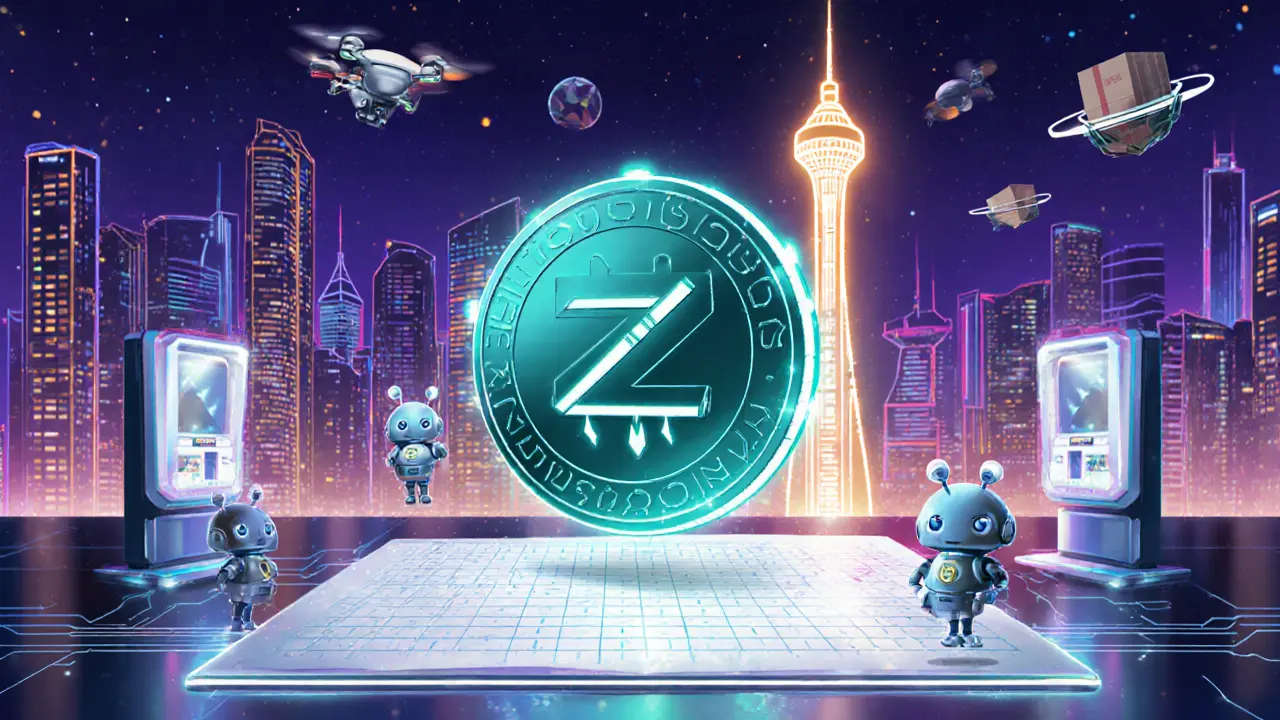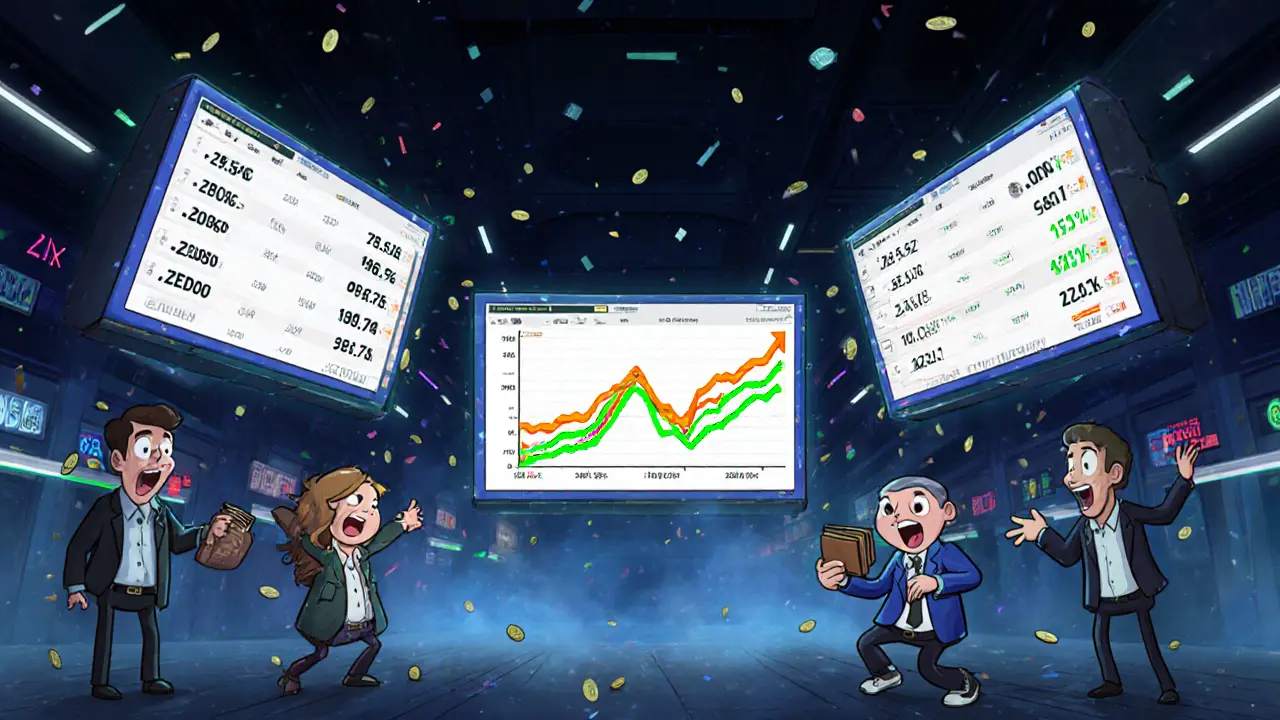
ZEDXION (ZEDX) Price Tracker
CoinGecko
Price: $0.2387
24h Change: 0.0%
Volume: $0
LiveCoinWatch
Price: $0.5325
24h Change: +1.95%
Volume: $6.8M
CoinMarketCap
Price: $0.5959
24h Change: +1.33%
Volume: N/A
Market Insights
The significant price discrepancies across trackers highlight the extremely low liquidity of ZEDXION (ZEDX). With minimal trading volume on most exchanges, large orders can cause substantial price swings. This makes ZEDX a high-risk investment with potential for dramatic volatility.
Key Takeaways
- ZEDXION is a DPoS‑based, EVM‑compatible blockchain aimed at crypto‑neobanking.
- It offers wrapped versions (WZEDX) on both Ethereum (ZED20) and Binance Smart Chain.
- Price data varies widely across trackers, highlighting very low liquidity.
- Acquisition is possible via credit‑card services, Web3 wallets, and a handful of DEXs.
- Investors should weigh technical promise against market‑depth risks.
What Is ZEDXION?
When you hear the name ZEDXION, think of a fresh blockchain platform that wants to blend fast payments with the flexibility of smart contracts. Launched in 2024, the project targets the emerging neobanking niche, promising to bring local fiat currencies onto a decentralized network while keeping transaction costs near zero.
The native token, identified by the ticker ZEDX, fuels every activity on the chain - from paying fees to staking for network security. Its design leans on a Delegated Proof of Stake (DPoS) consensus, meaning token holders elect a small set of validators to produce blocks quickly and efficiently.
Technical Foundations
The backbone of ZEDXION is its Delegated Proof of Stake (DPoS) model. Unlike energy‑hungry Proof‑of‑Work systems, DPoS lets a handful of elected delegates confirm transactions, delivering sub‑second finality and keeping the network’s carbon footprint low.
On top of that, ZEDXION is fully Ethereum Virtual Machine (EVM) compatible. Developers can write Solidity code, deploy existing Ethereum dApps, and interact with the broader DeFi ecosystem without learning a new language. This dual focus on speed (DPoS) and compatibility (EVM) is meant to attract both fintech startups and seasoned blockchain teams.
Tokenomics and Wrapped Implementations
ZEDXION’s native token, ZEDX, follows a standard ERC‑20‑style supply model, but the project also offers wrapped versions to broaden usability across chains. The Ethereum‑based wrapped token, known as WZEDX (ZED20), lives at contract address 0x3F7BE9DB9d37bd89c3Fa722BB29bA17300C18fc8. On Binance Smart Chain, the BEP‑20 wrapped token uses address 0xca30e772e4bd5f38ed775e6f8c57c6ffcb3c931f.
These wrappers enable users to move value between ecosystems, tap into BSC’s low‑fee environment, or stay on Ethereum for richer DeFi integrations. The dual‑chain approach also mirrors the project’s larger goal: to act as a bridge between fiat‑centered banking systems and the heterogeneous world of crypto.

Market Data, Liquidity, and Price Discrepancies
Tracking ZEDX’s market price is a lesson in why crypto data can be messy. Three popular aggregators report different numbers on the same day:
| Source | Price (USD) | 24‑hr Change | 24‑hr Volume |
|---|---|---|---|
| CoinGecko | $0.2387 | 0.0% | $0 |
| LiveCoinWatch | $0.5325 | +1.95% | $6.8M |
| CoinMarketCap | $0.5959 | +1.33% | N/A |
The spread hints at two realities: first, ZEDX trades on a handful of low‑liquidity venues; second, data feeds may not be synchronized across exchanges. CoinGecko even flags the token’s total liquidity as $0, warning users that price swings could be extreme.
For investors, the takeaway is simple: treat the market depth as fragile. Large buys or sells could move the price dramatically, and slippage is likely on any decentralized exchange (DEX) where ZEDX is currently listed.
How to Acquire ZEDXION Tokens
Because ZEDX isn’t listed on major centralized exchanges, buying it requires a bit more legwork. Here are the most common pathways:
- Credit‑card services: Some platforms partner with Binance’s on‑ramp to let users purchase wrapped tokens (WZEDX) directly with a card, then unwrap them to native ZEDX.
- Web3 wallets: Connect a wallet like MetaMask (Ethereum) or Trust Wallet (BSC), then swap a stablecoin (USDT, BUSD) for the appropriate wrapped version on a DEX such as PancakeSwap (BSC) or Uniswap (Ethereum).
- Direct DEX trade: Locate the ZEDX/USDT pair on a DEX that lists the token. Always verify the contract address before confirming the swap.
After acquiring the wrapped token, you can use the project’s official bridge (if available) to move it to the native ZEDX chain. Keep an eye on the project’s Discord or Telegram for bridge status updates, as early‑stage tooling can experience downtime.
Use Cases: Payments, DeFi, and Financial Inclusion
ZEDXION markets itself as a “crypto‑neobanking” platform. The core idea is to let everyday users pay for goods, send remittances, or earn yield without needing a traditional bank account. Because the chain runs on DPoS, transaction finality is often under a second, making point‑of‑sale usage plausible.
Beyond payments, the EVM compatibility opens doors to standard DeFi primitives-lending, borrowing, and yield farming-built directly on ZEDX. Developers can launch a stablecoin pegged to a local fiat, then integrate it with ZEDX’s fast settlement layer to provide near‑instant cross‑border transfers.
In theory, such a setup could boost financial inclusion in regions where banking infrastructure is weak but mobile internet is widespread. The white paper cites billions in daily transaction volume potential, though real‑world adoption remains in its infancy.
Risks and Investor Considerations
Every crypto project carries risk, and ZEDXION is no exception. Below are the main red flags to weigh:
- Liquidity scarcity: As noted, most price aggregators show minimal trading volume. Large orders can cause extreme slippage.
- Exchange fragmentation: The token lives on Ethereum, BSC, and its own chain, but each market fragment reduces overall depth.
- Regulatory uncertainty: Neobanking sits at the intersection of finance and crypto, attracting scrutiny from regulators worldwide.
- Competition: Established DeFi platforms (e.g., Polygon, Solana) already offer fast, cheap payments. ZEDX must prove a unique value proposition to win users.
- Development transparency: While the white paper is public, detailed roadmaps and recent updates are sparse. Investors should monitor community channels for real‑time progress.
Given these factors, many analysts recommend treating ZEDX as a high‑risk, high‑potential play. Allocate only what you can afford to lose and consider diversifying across more liquid assets.
Frequently Asked Questions
What blockchain does ZEDXION run on?
ZEDXION uses its own Delegated Proof of Stake (DPoS) blockchain that is fully compatible with the Ethereum Virtual Machine (EVM).
How can I store ZEDX safely?
A hardware wallet that supports ERC‑20 and BEP‑20 tokens (e.g., Ledger or Trezor) can hold the wrapped versions. For native ZEDX, use a wallet that integrates the ZEDX chain, such as the official ZEDX mobile app or a compatible Web3 wallet configured with the chain’s RPC endpoint.
Why do price feeds show different numbers?
The token trades on a few low‑liquidity DEXs, and each aggregator pulls data from different sources. Small volume means a single trade can shift the price, causing noticeable gaps between sites.
Is ZEDXION suitable for everyday payments?
In theory, yes. The DPoS consensus delivers sub‑second finality and sub‑cent transaction fees, which are ideal for point‑of‑sale scenarios. Real‑world adoption depends on merchant integration and stablecoin pairing.
What are the biggest risks of investing in ZEDX?
Low liquidity, regulatory scrutiny of neobanking services, competition from established fast‑blockchain networks, and limited public roadmaps are the primary concerns. Conduct thorough due diligence before allocating capital.


Comments
Petrina Baldwin
ZEDX is a joke. Zero liquidity and price gaps? This is pump-and-dump bait.
Ralph Nicolay
The technical architecture exhibits a non-trivial alignment with contemporary blockchain interoperability paradigms. However, the absence of audited smart contracts and verifiable liquidity pools introduces material fiduciary risk.
sundar M
Brooo this is actually fire! 🚀 ZEDXION could be the real deal for folks in India who can't get bank access but have a phone. DPoS + EVM? Yes please! I already swapped some USDT for WZEDX on PancakeSwap. Low volume? Bro, it's early! Let it breathe 😌
Nick Carey
Another crypto project that thinks 'EVM compatible' means 'I'm legit'. Bro, CoinGecko says $0 liquidity. That's not a feature, that's a funeral bell. I'm gonna go watch paint dry instead.
Sonu Singh
I tried to buy ZEDX yesterday on uniswap and got scammed by a fake contract 😭 the real one is 0x3F7BE9... but i misspelled it and lost 0.5 eth. dont trust any link without double checking the address. also the bridge is down again. project needs to fix this fast
Alex Horville
This is just another foreign crypto scam trying to steal American money. We don't need some Indian blockchain pretending to be neobanking. Stick to Bitcoin, America.
Marianne Sivertsen
I'm not sure if this is genius or just chaos. The idea of blending fast payments with DeFi is beautiful... but the market data looks like someone threw darts at a price board. I'd keep a tiny position. Just enough to see if it grows up or just fades away.
Shruti rana Rana
This is truly inspiring for emerging economies! 🌏✨ ZEDXION could empower millions without bank accounts. Imagine a farmer in Bihar sending money home in seconds, not days. The tech is solid - now let’s build the trust. 🙏 #CryptoForAll
Stephanie Alya
Oh wow, $0 liquidity? 😂 So you're telling me I can buy this for $0.23 and then sell it for $0.59? Bro, that's not a market, that's a magic trick. I'm buying 10,000. Who's with me? 🤷♀️💸
olufunmi ajibade
I'm from Nigeria and I've seen 100 of these 'revolutionary' blockchains come and go. But this? The DPoS speed and EVM compatibility? This might actually work. We need this. Not for speculation - for survival. If you're serious, help us build the local on-ramps. We're ready.
Manish Gupta
Wait so WZEDX on BSC is at 0xca30... but on CoinMarketCap it shows a different address? That's confusing. Is this a fork? Or just bad data? I'm lost now 😅
Gabrielle Loeser
While the technological framework presents compelling advantages, the absence of regulatory clarity and the fragmentation of liquidity across multiple chains present substantial barriers to institutional adoption. Prudent investors should await third-party audit disclosures and exchange listings before committing capital.
Cyndy Mcquiston
Liquidity is zero so it's a scam